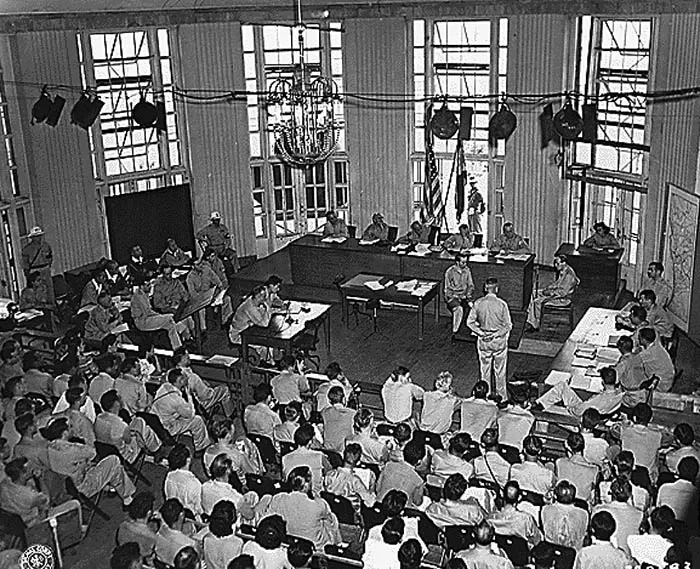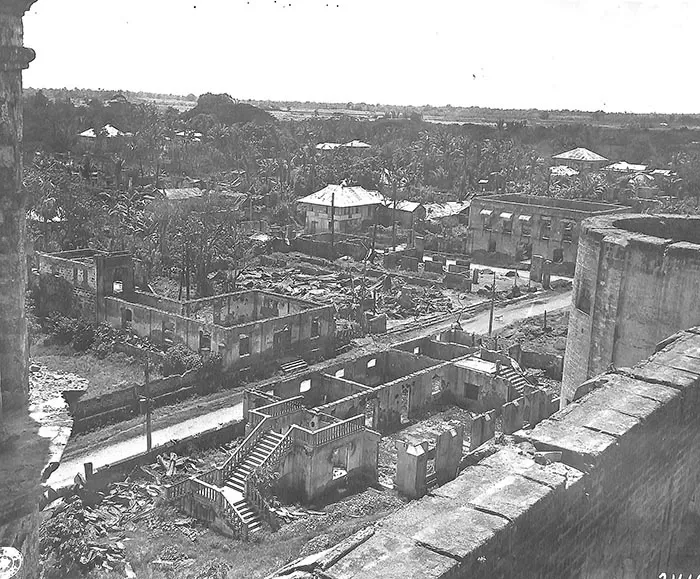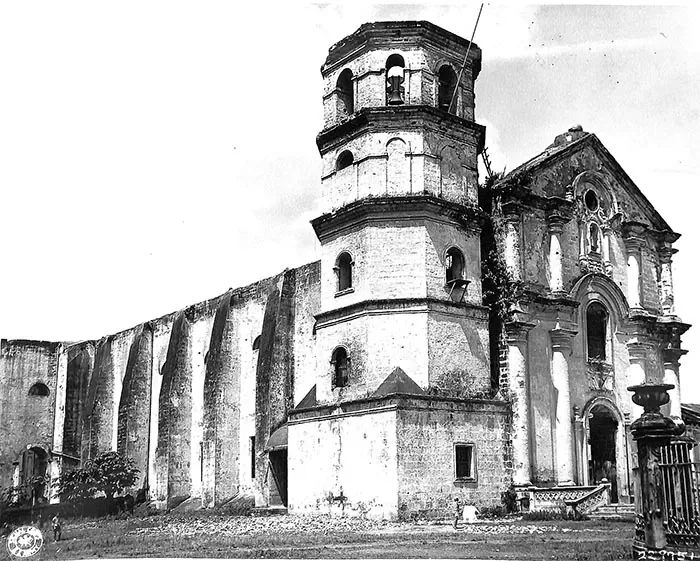Testimony of Jose M. Katigbak on Japanese Atrocities Committed in Lipa, Batangas in 1945 Part I
PART I
PART I | PART II
[TRANSCRIPTION]
This page contains the testimony of Jose M. Katigbak on Japanese atrocities committed in the town of Lipa, Batangas in 1945. The pages contained herein are now declassified and were part of compiled documentation1 of war crimes trials conducted by the United States Military Commission after the conclusion of World War II. This transcription has been corrected for grammar where necessary by Batangas History, Culture and Folklore. The pagination is as it was contained in the original document for citation purposes.
 |
| Photo taken during the war crimes trials in Manila. Image credit: U.S. National Archives. |
[p. 1587]
JOSE M. KATIGBAK
DIRECT EXAMINATION
A Jose M. Katigbak.
Q Where do you live?
A Lipa, Batangas.
Q What is your profession?
A Physician.
Q And in addition to being a physician, do you hold any other position?
A I am the acting mayor of Lipa, Batangas.
[p. 1588]
A Since April 23, 1945.
Q During the Japanese occupation of Lipa and before their withdrawal from Lipa, did they do anything to the city?
A Before their withdrawal from Lipa, there was a preparation, a deliberate preparation for the destruction of the town.
Q What did they do in preparation for the destruction of the town?
A All the big houses were provided with drums of gasoline. The small houses were also provided with bottles of gasoline.
Q With what?
A Bottles containing gasoline. This, they placed in all houses. There was also a preparation for a sure destruction of the town by having some of the soldiers drill in throwing lighted bottles of gasoline on the walls, in order to break them and be sure of the flames that would get out of the bottles of gasoline.
Q What happened when the Japanese withdrew?
A Before they withdrew, it was somewhere around about the end of March, a portion of the town had been burned.
Q By whom?
A By the Japanese.
Q Alright. What happened then?
A Then, on the 27th of March — that is, Tuesday of Holy Week — the whole town was set on fire.
[p. 1589]
A By the Japanese.
Prosecution Exhibit No.
259 for identification.)
A This is part of the town of Lipa, looking southward from the bell tower.
Q Is that a correct representation of the way the portion of Lipa shown in that photograph looked after the Japanese had burned the town?
A Yes, sir.
GENERAL REYNOLDS: There being no objection, it is accepted in evidence.
259 for identification
was received in evidence.)
Prosecution Exhibit No.
260 for identification.)
A This is a picture of the portion of the town looking northward, after the destruction.
Q Does that correctly show the way that portion of the town looked after it was burned
A Yes, sir.
Q There appear in that picture roofs that appear to be of a temporary nature, and several items like that. Have they been added since the fire?
[p. 1590]
There being no objection, it is accepted in evidence.
260 for identification
was received in evidence.
Prosecution Exhibit No.
261 for identification.)
A This is the portion of the town looking westward from the bell tower, after the destruction of the Japanese.
GENERAL REYNOLDS: There being no objection, it is accepted in evidence.
261 for identification
was received in evidence.)
Prosecution Exhibit No.
262 for identification.)
A The convent, which was located near the cathedral, was also provided with drums of gasoline.
Q And did the cathedral and convent burn?
A Both of them burned down.
Q Will you look at Exhibit 262 for identification, and state what it shows?
[p. 1591]
GENERAL REYNOLDS: There being no objection, it is accepted in evidence.
262 for identification
was received in evidence.)
Prosecution Exhibit No.
263 for identification.)
A This is the inside of the Lipa Cathedral after it had been destroyed.
263 for identification
was received in evidence.)
A Before the evacuation, the other destruction [that] was done was the confiscation of whatever belongings that were left behind by the people in their rush in going away; such as corimatas [carromata, a horse-draw carriage], automobiles, clothes, and all other animals — for example, chickens and cows; all had been taken away by the Japanese.
Q Did they pay for them?
A No.
Q Was anything else destroyed?
[p. 1592]
Q How about municipal facilities?
A The municipal building, the electric light plant, were totally blown up, and also the water system was destroyed.
Q What destruction, if any, occurred in Lipa due to American bombing or shelling?
A There were around ten houses that were bombed by the Americans. Now, these houses that were bombed, were previously marked by the ROTC Hunters guerrilla unit, which had its headquarters in Lipa.
Q Nothing was destroyed other than the ten houses that were bombed after they had been marked by the guerrillas, is that right?
A That is what has been the report of the guerrillas.
Q Now, as municipal mayor for the municipality of Lipa, did you receive orders from the Governor of the Province of Batangas to conduct an investigation?
A Yes, sir.
Q What was the nature of the orders which you received?
A The orders were for the investigation of the destruction of property, property losses, the number of houses that had been burned, and the number of people that had been killed?
Q Now, has your office, under your supervision, made an investigation into the number of people killed?
A Yes, sir.
Q In the municipality of Lipa?
A Yes, sir.
[p. 1593]
A Up to this time, it has not been completed, because most of the places are rather inaccessible at this time.
Q How does your staff investigate the people who were killed?
A By indulging — giving the barrio lieutenants instructions to get the names of all the people in their barrio that had been killed.
Q And have the barrio lieutenants in your municipality, some of them, submitted lists?
A Yes, sir.
Q Pursuant to your orders?
A Yes, sir.
Q And have you compiled these lists?
A Yes, sir.
Q In connection with your official duties?
A Yes, sir.
ed Prosecution Exhibit No.264 for identification.
A Yes, sir. This is the list of the dead persons who died by massacre under the Japanese hands, which had been compiled in our office, a partial list.
Q You say this is a partial list?
A Partial list.
Q Is that an official record of the deaths compiled by your office?
A Yes, sir.
[p. 1594]
A Yes, sir.
Q How many names does it contain?
A That list, I think, contains around 2164.
Q In addition to these 2164 dead people listed here, what is your estimate of the number of people were were residents of Lipa who were killed by the Japanese?
A The residents —
CAPTAIN REEL: Just a moment. Since the question adds the term “by the Japanese,” we object to it; there has been no evidence of that at all. When the time comes when the Prosecution seeks to admit this, we will object to it on that basis; but since the question has been asked with those words, we will object to the question.
CAPTAIN PACE: I will withdraw the question, and at this time offer Prosecution Exhibit 264 for identification in evidence.
CAPTAIN REEL: Defense objects to the exhibit, sir, for the following reasons: in the first place, it is entirely beyond this witness’ personal knowledge. In the second place, this list purports to be — and I quote from it — a list of persons massacred by the Japanese in Pangao, Lipa, Batangas. There is no evidence that this list of persons was massacred by the Japanese. It is beyond this witness’ personal knowledge. In addition, this witness has testified that there were shelling by the American forces in that town; undoubtedly, some people died from those shelling. This witness has further testified, sir, that Lipa was the headquarters of the Hunters
[p. 1595]
GENERAL REYNOLDS: The Commission will withdraw for deliberation.
(Whereupon, the members of the Commission retired for executive session.)[p. 1596]
Subject to this interpretation, the document is accepted by the Commission for such probative value as it considers appropriate.
for identification was
received in evidence.)
CAPTAIN REEL: Sir, may I ask that the reporter read back the first question and answer after the exhibit was first shown to the witness?
GENERAL REYNOLDS: Very well.
(The question and answer referred to were read by the reporter as follows:
“Q Will you look at Prosecution Exhibit 264 for identification and tell me if you can identify it?
“Yes, sir. This is a list of dead persons who died by massacre under the Japanese hands which had been compiled in our offices — a partial list.”)
CAPTAIN REEL: Sir, because of the ruling of the Commission, we ask that the question and answer be stricken from the record.
GENERAL REYNOLDS: The Commission directs that the question and answer be stricken from the record.
[p. 1597]
A The order that we received was to prepare a list of persons who were massacred during the Japanese regime.
Q Pursuant to that order, what instructions did you give your subordinates?
A I told the subordinate lieutenants to take only the names of all persons that died under these circumstances.
Q What circumstances?
CAPTAIN PACE: I submit, sir, that the document is worthless unless the method of its preparation, the purpose of its preparation, and the circumstances under which it was prepared are also in evidence.
GENERAL REYNOLDS: The Commission would have received and considered such testimony prior to the introduction of the document. The Commission has considered the points raised and it desires that further questioning as to the method used with regard to the document is omitted.
CAPTAIN PACE: Yes.
[p. 1598]
Q Does it contain the names of people who are known to have died natural deaths?
A No, sir; because of that, we have a list in the municipality.
Q In the municipality of Lipa, do you know how many people were killed due to the hazards of war, such as American or Japanese artillery fire?
CAPTAIN REEL: Sir, we object. We understood that the Commission had ruled on this subject.
GENERAL REYNOLDS: The objection of counsel is sustained.
CAPTAIN PACE: Am I to understand, sir, that we are allowed to show that the city records of Lipa, which supplement this list and their relation to it —
GENERAL REYNOLDS: As to the list which has been presented to the Commission on which this Commission has ruled, the matter is considered closed.
CAPTAIN PACE: Yes, sir.
A That is only a partial list that we have handed to the committee of — War Crimes Committee.
Q How many people do you estimate in your official capacity were killed by the Japanese during the period in question?
[p. 1599]
GENERAL REYNOLDS: The objection is sustained.
MAJOR KERR: Sir, is the Prosecution to understand, then, that the Commission will receive no testimony from this witness concerning who killed whom and how many in Batangas Province —
GENERAL REYNOLDS: The Commission—
MAJOR KERR: We are not seeking now, sir, to discuss the list in evidence, but I believe we qualified this witness to show how many people were killed by the Japanese. That is the purpose of the line of questioning now.
GENERAL REYNOLDS: The Commission feels that the ruling announced was entirely clear and adequate. It has accepted this list as names of people who are known missing from the area and in some cases known to be dead. It does not seem to the Commission that after that ruling, it is appropriate for the Prosecution to pursue the matter further. As far as that ruling governing on the presentation of any future documents, we will consider those future documents on their merits when they are presented to us for consideration.
MAJOR KERR: Then we are free, sir, to proceed with this witness outside of the list which is in evidence to show the deaths which did occur by Japanese action in his area? Is that correct, sir?
GENERAL REYNOLDS: It would seem to the Commission that if we were to do that, he would testify as to his personal knowledge and not from the documents which have already been accepted by the Commission.
[p. 1600]
CAPTAIN PACE: Will you read the question?
(Question read.)
GENERAL REYNOLDS: That is an example of questions which the Commission considers inappropriate and will not be answered.
A About seven —
GENERAL REYNOLDS: If the witness is testifying by his personal knowledge, there is no objection to the question.
CAPTAIN PACE: I will ask a preparatory question, sir.
A Yes, sir.
Q Will you state how many people you estimate to have been killed by the Japanese?
[p. 1601]
CAPTAIN PACE: If the Commission, please, I called this witness as an official and it is my understanding that in any court of law, an official can testify to things which he has learned through subordinates which have been collected due to official instructions. If that is what the Commission means by “personal knowledge,” I think that the witness is qualified to answer the question.
GENERAL REYNOLDS: As to the information he received by official investigation, it is contained in this document. And, once more, the Commission announces the matter is close.
CAPTAIN PACE: Yes, sir.
GENERAL REYNOLDS: This witness, like any other person, may testify as to his personal knowledge.
A From natural and other causes, the number of people that died there is more than 10,000.
Q Of those 10,000, how many of them died from natural causes?
CAPTAIN REEL: Sir, we object unless there is some showing that this witness has personal knowledge, which the Commission has insisted upon.
GENERAL REYNOLDS: Objection is not sustained.
[p. 1602]
Q (By Captain Pace) Other than the people who were residents of the Municipality of Lipa, did residents of other municipalities die there from other than natural causes?
A Yes, sir.
Q How many of those?
A There were more or less 1,000; between 500 and 1,000.
Q And how many of those died of natural deaths?
A There were less than a hundred, I think.
CAPTAIN REEL: Sir, we will ask that the answer be stricken. The witness obviously is not testifying from his personal knowledge. He said, “less than 100, I think.” This does not comply with the Commission’s ruling.
GENERAL REYNOLDS: The objection is not sustained.
A There was a very slight fighting [that] took place there.
Q Well, will you give the scale of the fighting as you knew it?
A The Japanese withdrew to the mountains. There, they did not venture to go out of their hiding place during daytime, so whatever fighting took place was the bombing of the Japanese concentrations in the foot of the mountains.
Q Were any of the residents of Lipa in the mountains with the Japanese where these bombings took place?
[p. 1603]
Q Approximately how many residents were there?
A There will be about 3,000 people down there.
Q From the municipality?
A From the municipality.
Q Have the figures you have given us included those people?
A From my municipality, that mountain is surrounded by three municipalities and some of these Filipinos down there are from other municipalities. From my municipality, there were about 2,000 that were there.
Q Were you considering those people in the figures which you have given us?
A Pardon me?
Q The figures which you have given us, have they taken into consideration the people at the foot of the mountains with the Japanese?
A Those were the people of Lipa that were taken into the mountains.
Q Are you considering them when you give us these figures which you have testified to?
A In the killings?
Q Yes.
A No, sir.
Q How much bombing occurred in your municipality by either the Americans or the Japanese?
A There were plenty of bombings that we are unable to
[p. 1604]
Q Do you know how many people were killed by that?
A We were not able to get into the concentration camp.
CROSS-EXAMINATION
A During all my life except when I studied here in Manila.
Q And have you during that entire period been always in close touch with public affairs in Lipa?
A Yes, sir; after I graduated from the College of Medicine.
Q And would you say that you are well qualified to speak about everything that happened in Lipa?
A I am.
Q And would you also say that you are sure that nothing of public importance would occur in Lipa about which you would not know?
A I think so.
Q What was the population of Lipa in 1944?
A 1944, there was no census taken during that day — that year.
Q As a man familiar with public affairs, what would you estimate the population?
A The population of Lipa with the census taken in 1939 was 45,000.
PART I | PART II





